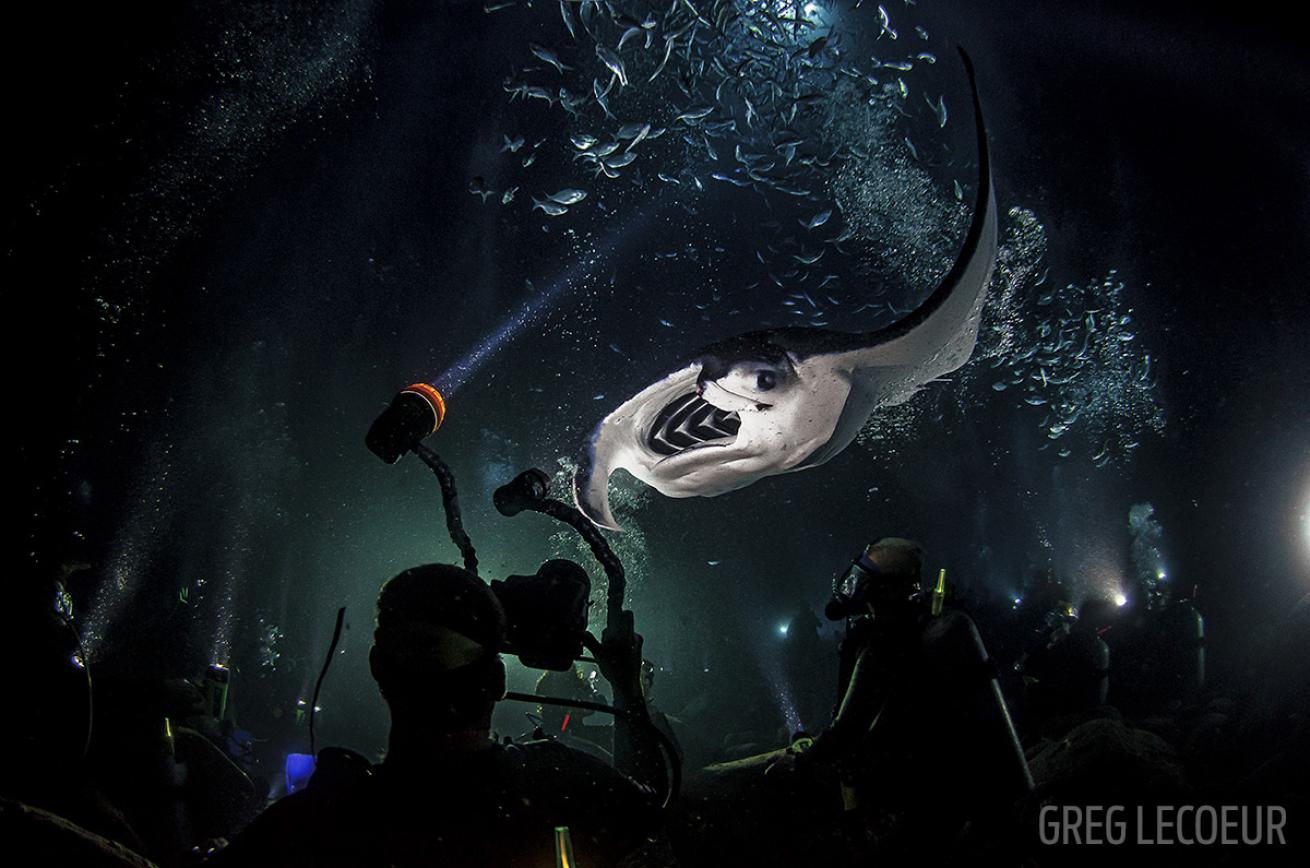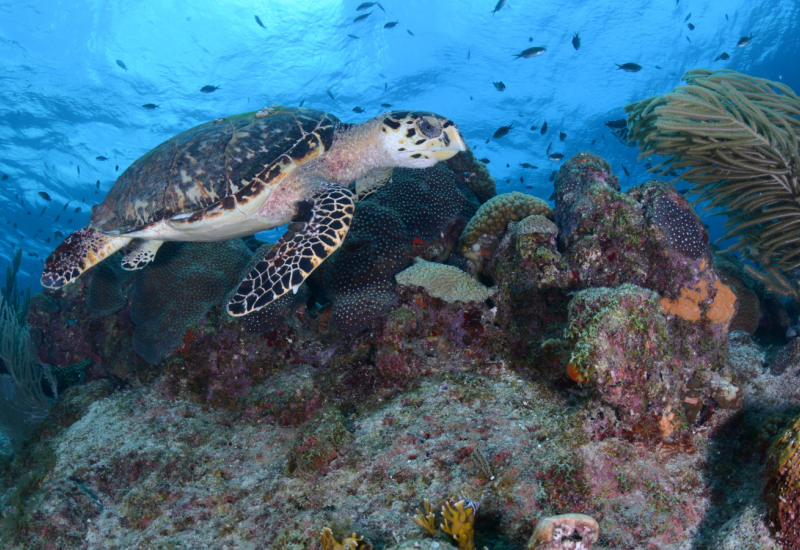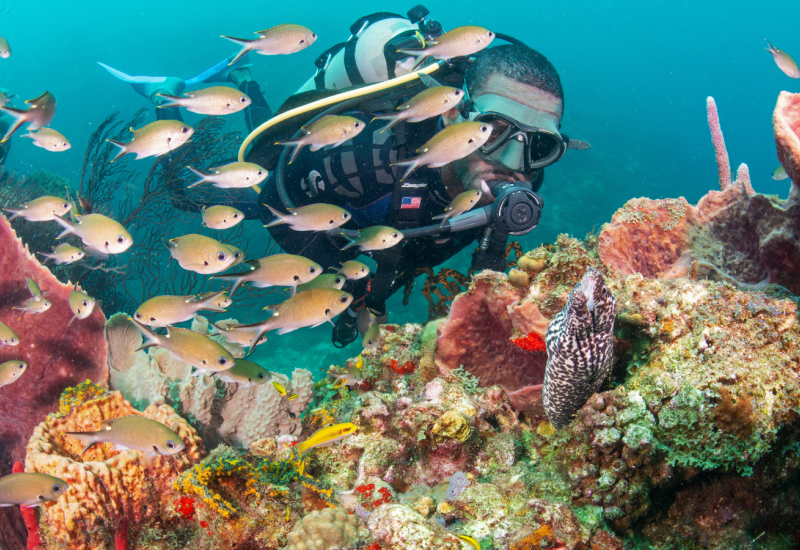Best Night Diving Destinations From Around the World

Fabien MichenetIt’s a squid-eat-squid world in deep waters after dark, a couple of miles off Tahiti.
When the sun goes down, the party kicks into high gear — the freaks come out at night. The underwater world is no different. As the reef transitions from daylight to darkness, wondrous creatures that hide during the day come alive to prowl the reef in nocturnal splendor, from stealthy hunters like sharks and octopuses to ghostly glowing plankton, bizarre alien larvae and all manner of life in between. Wrecks, jetties and piers take on new personalities under cloak of night. All you need to get your groove on is a bright light and a healthy sense of adventure.
Wreck Diving
Grand Cayman, Cayman Islands

Alex MustardKittiwake's chamber.
Shipwrecks that are ominous and emotionally moving during the day take on a new level of eerie after the sun goes down. But few are safe to penetrate at night for even experienced wreck divers — unlike Grand Cayman’s Kittiwake. This purpose-sunk artificial reef boasts wide-open corridors and interior rooms with multiple exit opportunities that are accessible (with proper guidance) to divers of any skill level. “Night diving the Kittiwake is an experience you do not want to miss,” says Jo Mikutowicz, managing partner of Grand Cayman’s Divetech. “The wreck is alive with marine life out hunting, and the many openings to the outside are lit by the moon and stars.” If you’re brave enough to swim out beyond the wreck and turn off your light, the dance of beams from your dive mates probing the ship provide a cosmic light show worthy of your best college flashback.
Muck Diving
Lembeh Strait, Indonesia

Steve JonesPredatory bobbit worm.
Muck diving, synonymous throughout the dive world with the strange and unexpected, gets only more interesting at night. Some of the muck’s rarest star attractions emerge only after dark. Lembeh Strait, Indonesia’s muck magnet off North Sulawesi, boasts nighttime action galore across its barren, dark sand flats. Mind-blowing sights are common, from frogfish to stargazers, ghost pipefish, blue-ringed octopuses, nudibranchs and beyond, and underwater photographers will find opportunity to start crossing off heaps of their critter-shot bucket list. Shooting them at night presents added challenge, but it also increases the opportunity to create truly stunning images.
lembehresort.com
Shark Diving
Cocos Island, Costa Rica

Scott JohnsonNighttime is the right time for whitetip hunting and feeding in frenzies in Cocos.
Sharks are notorious nocturnal hunters, but few places are safer — or more exciting — to witness their undercover antics than Manuelita Shallows, a coral garden at world-renowned Cocos Island National Park. Located about 340 miles off the Pacific coast of Costa Rica, this isolated island, sometimes called “Little Galapagos,” is a magnet for marine life, thanks in part to a rich convergence of oceanic currents and its designation as a marine protected area with no fishing since 1982. Each night large numbers of whitetip sharks congregate to hunt like a pack of wild dogs in hard-coral mazes. The sight, when viewed from a yard or two above the action in the water column, is a rare and thrilling experience.
aggressor.com
• More Shark Night Dives
Bioluminescence Diving
Florida Keys

Russ TaylorWhite Horse Key, Everglades
Like a million twinkling lights that react to the touch, the natural phenomenon of bioluminescence is a stunning seasonal occurrence found around the world that will delight any diver. Created by microorganisms, plankton and other minute critters from a chemical reaction that creates light as a defense mechanism, the light show is dependent upon very warm water and dark skies with a new or no moon. In the Florida Keys, divers can create trails, swirls and otherworldly patterns of glowing water simply by moving their arms or fins through water populated by the unseen creatures. When bioluminescence is in full swing, it gives new levels of fun to any safety stop. In fact, you probably won’t want to surface until your tank is completely empty.
rainbowreef.us
oceandivers.com
Drift Diving
French Polynesia

Anthony BerberianA new species of jellyfish—Eutiara decorata—discovered three miles off Tahiti.
One of the most unnerving experiences in the universe of night diving has to be the infamous black-water drift dive. Pioneered in Hawaii but quickly spreading through the Pacific, including French Polynesia, the process is simple — suspend divers under the boat on tethers over water that’s thousands of feet deep. The goal: Watch for larval organisms that rise each night to feed. The sights: too strange to describe. Otherworldly creatures with transparent bodies, glowing parts and bizarre appendages float in the water column for divers’ delight. Just try not to think about the other marine life that prefer to hunt for larger prey at this same time of night. Thankfully the experience is worth any level of heebie-jeebies you might feel.
tahitiitidiving.com
Fluorescent Diving
Bonaire

Barry BrownA Bonaire bearded fireworm fluoresces under blue light on a batwing crab carapace.
For divers accustomed to the night who think they’ve seen it all, fluorescent diving in the dark offers an entirely new view on the reef and its inhabitants. When illuminated with a specialized ultraviolet light and viewed through a yellow mask filter, critters that once looked mundane under white light will glow with neon-bright, psychedelic patterns. Corals, anemones, fish, worms, crustaceans — just about everything under the sea looks wildly different and more exciting. As the technology spreads across the globe, the opportunity to view the underwater world in this special way will be more accessible. Until then, Buddy Dive in Bonaire has been offering the specialty night dive for several years, and can provide the equipment and lead you to the coolest sights. “A fluorescent night dive is a trip to another world,” says Buddy Dive operations manager Augusto Montbrun. “The secret world of the glow-in-the-dark creatures we normally don’t see during a regular night dive unveils a fantastic show that is there waiting for us to discover.”
buddydive.com
• More Fluorescent Night Dives
Structure Diving
Raja Ampat, Indonesia

Debbie ArriagaThe soft corals of Arborek Jetty rival any daytime garden.
Deep in the Coral Triangle in the Raja Ampat region of Indonesia, Arborek Jetty is a magnet for liveaboards such as Arenui hoping to show their guests some incredible structure diving. As the sun drops below the horizon, the operators drop their divers at the base of the ramshackle pier, where soft corals in a rainbow of colors adorn the tall pilings, creating safe harbor for countless variety of tropical fish schooling in large numbers. And each piling is a microcosm of oddities, from wild pipefish to pygmy seahorses, exotic crabs, bizarre shrimp, crocodilefish and beyond. “Arborek Jetty at night completely transforms,” says Arenui cruise director and photographer Debbie Arriaga. “Instead of looking up, you are looking down in the hunt for super-special critters such as blue-ringed octopuses, juvenile pinnate batfish, frogfish and harlequin shrimp. Among the jetty’s posts, listen for the calls of toadfish echoing underwater, and look out for green eyes — that just could be a walking shark.” By moving slowly and keeping your torch trained on the nooks and crannies, there’s no telling what alien life-forms you might encounter.
thearenui.com
Manta Diving
Kona Coast, Hawaii

Greg LeCoeurKona's justifiably famous Manta Night Dives are the mother of all after-hours encounters.
Just off the picturesque Kona coast of the Big Island of Hawaii, there’s a chance to party with the big boys each night. The world-famous Manta Night Dive, started by area dive operators in the 1990s, features dozens of massive manta rays performing mind-blowing choreography under a bright, man-made light show. Illuminated by floating rigs of powerful spotlights, as many as 20 graceful filter feeders swoop and dive in a feeding frenzy on the plankton and other tiny organisms drawn to the lights. Lucky divers watch the show from the shallow bottom while snorkelers get a different vantage point floating above. “The amount of light at the site is tremendous, so it’s very different than a typical night dive,” says Keller Laros, a dive instructor for Jack’s Diving Locker and president of the Manta Pacific Research Foundation. Watching “these large, graceful sea creatures swimming just overhead, performing a beautiful ballet in an illuminated underwater theater is spectacular. People are usually blown away seeing such large ocean animals so close.”
jacksdivinglocker.com
konahonudivers.com
Spawning Diving
Curaçao

Alamy Stock PhotoDirected by the moon, the corals wait for prime conditions to release their eggs and sperm into the water column.
Each summer, corals of numerous variety undergo a spectacular display of spontaneous reproduction — and divers can watch the entire sordid affair. Directed by the moon, the corals wait for prime conditions to release their eggs and sperm into the water column, where they mix and mingle with others to repopulate the reef, but also become a tasty snack for opportunistic fish. If the timing is right, you won’t find a better reason to stay up late on your next summer dive trip. “It’s pure excitement from start to finish,” says local Curaçao professional underwater photographer Barry Brown. “Every diver we have ever taken can be heard underwater screaming in pleasure while the eggs are releasing. It’s magical.”
oceanencounters.com










